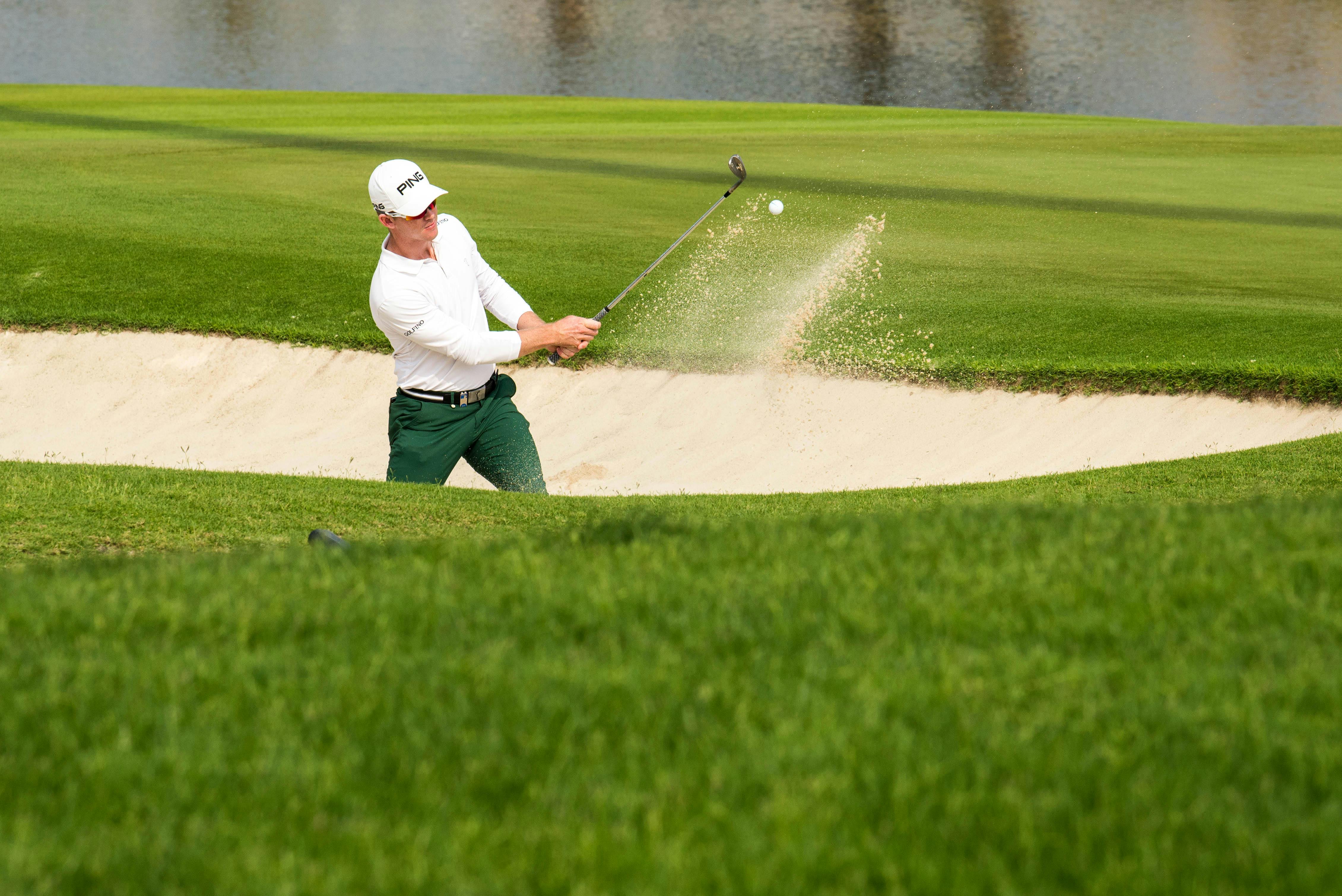Golf balls are a vital component of the game of golf, and they are designed to give players the best performance possible. One of the most recognizable features of a golf ball is its dimples. But have you ever wondered how many dimples are on a golf ball? In this article, we will explore why golf balls have dimples, how many dimples there are on a typical golf ball, and what purpose they serve.A golf ball typically has 336 dimples.
What is the Purpose of the Dimples on a Golf Ball?
The dimples on a golf ball are integral to the aerodynamics of the flight. The dimples create a thin boundary layer of air that clings to the surface of the ball, creating turbulence and reducing drag. This turbulence reduces drag by allowing air to flow more smoothly around the ball, resulting in increased lift and less spin. As a result, golf balls travel farther and straighter than smooth balls. Additionally, dimples can also reduce the amount of backspin on a ball when it is hit, allowing for greater control over shots.
Dimples also help with accuracy by providing more stability in flight. The dimples act as tiny wings that guide the ball through its trajectory more accurately than a smooth surface would. This helps golfers maintain greater accuracy with their shots and can even help them hit shorter or longer shots depending on what they are intending to do.
Finally, dimples can increase visibility for golfers. Dimpled surfaces reflect light differently than smooth surfaces, which makes them easier to spot as they fly through the air. This allows golfers to track their shots better and make any necessary adjustments as they go.
Dimples on a Golf Ball
Dimples on a golf ball can have an impact on the performance of the ball. They can help with the aerodynamics of the ball and improve its distance and accuracy. There are several factors that affect the number of dimples on a golf ball, such as size, surface texture, spin rate, and type of material used.
Size
The size of a golf ball is an important factor when it comes to dimple design. Smaller balls require fewer dimples in order to achieve the same level of lift as larger balls. This is because smaller balls have less surface area for air to act upon, so they need less lift from the dimples in order to stay in flight for longer periods of time.
Surface Texture
Surface texture also plays an important role in determining how many dimples are needed on a golf ball. Rough surfaces require more dimples since air will not be drawn smoothly across them like it would on a smoother surface. The increased turbulence caused by these rough surfaces will create more drag and thus require more lift from the dimples in order to counteract this drag.
Spin Rate
Spin rate is also an important factor when it comes to determining how many dimples are needed on a golf ball. The higher spin rate generated by a club will cause more turbulence which will reduce aerodynamic lift, so more dimples will be needed in order to counteract this effect and maintain optimal performance.
Type of Material Used
The type of material used for constructing the golf ball can also affect how many dimples are needed in order to achieve optimal performance. Materials like rubber or plastic have different densities which affect how much lift they can generate with each stroke or putt, so different amounts of dimpling may be required depending on the material used.
Overall, size, surface texture, spin rate, and type of material used all play an important role in determining how many dimples are necessary for optimal performance from a golf ball. By understanding these factors and their effects on aerodynamic performance, golfers can make informed decisions about which type and number of dimple design is best suited for their game.
How Do Dimples Increase Distance in Golf Balls?
Dimples are a key factor in the performance of a golf ball. They act as tiny pockets of air that reduce drag, allowing the ball to fly further and with greater accuracy. When a golf ball is struck, the air around it pushes against the surface of the ball. If there were no dimples, this air would cause more turbulence around the ball, resulting in more drag and less distance. Dimples create pockets of low pressure air around the ball, reducing drag and allowing it to fly farther.
The dimples also cause turbulence on the upper surface of the golf ball which helps to keep it in the air longer. This is because when a golf ball spins, its upper surface spins faster than its lower surface. This causes an area of low pressure to be created above the golf ball which helps to keep it floating for longer and thus travel farther distances.
Dimples also help to make sure that a golf ball stays on its desired trajectory after being hit by reducing side spin and keeping it flying straight for longer distances. With less spin on the golf ball, any windy conditions have less effect on where it will go and thus increasing accuracy as well as distance for each shot.
Overall, dimples are an important factor when considering how far a golf ball will travel after being hit as they reduce drag and increase lift which results in higher distances for each shot taken. With their help, even inexperienced players can benefit from increased distances when playing their game of choice with proper technique.
Different Types of Dimple Patterns on Golf Balls
Golf balls are one of the most important pieces of equipment in the game of golf. The dimple pattern on the surface of a golf ball is an important factor in determining its flight path and performance. Different types of dimple patterns can affect the spin, trajectory, and distance that a ball can travel. The dimples on a golf ball are designed to create turbulence in the air around it, reducing drag and allowing it to travel farther. There are several different types of dimple patterns that can be found on golf balls, each designed for different kinds of shots and playing styles.
The most common type of dimple pattern is the 432-dimple pattern, which has 432 shallow indentations evenly distributed around the surface of the ball. This type of pattern is designed to provide maximum lift and distance with minimal spin. It is best suited for players who hit long shots but don’t need much control over their spins.
Another popular type of dimple pattern is the 338-dimple pattern, which includes 338 deeper indentations than the 432-dimple design. This type of dimple pattern is designed to provide more spin and control than its predecessor, making it ideal for players who need more control over their shots and spins.
Finally, there is a newer type of dimple design called hexagonal dimples, which has hexagon-shaped indentations instead of traditional circular ones. This type of design creates less drag than traditional circular designs and allows for more accurate shots with less spin. It also provides more backspin when hitting shorter shots due to its unique shape, making it ideal for players who prefer more control over their game.

Does More Dimples Mean Better Performance in Golf Balls?
Dimples are an integral part of golf balls and have been so since the 1890s when they were first introduced. The purpose of dimples has remained the same – they help to reduce drag and increase the distance a ball can be hit. Dimples also help to reduce sidespin, which is critical for accuracy in golf shots. But does more dimples mean better performance in golf balls?
The short answer is yes, more dimples do mean better performance. Dimples create turbulence around the golf ball, which helps to reduce drag and keep the ball in the air longer. This increased lift helps to improve accuracy and distance off the tee, making it easier for golfers to hit their shots straight and far. The more dimples a golf ball has, the more lift it will generate and thus provide better performance for players.
However, not all dimpled balls are equal when it comes to performance. Different types of golf balls have different numbers of dimples as well as different shapes and sizes. The type of ball chosen should depend on the player’s individual needs and style of play. A player with a higher swing speed may benefit from a ball with fewer but larger dimples while a player with a slower swing speed may find that a ball with more but smaller dimples works best for them.
In addition to different numbers of dimples, some manufacturers also produce golf balls with different depths of dimple patterns that can improve performance further. A shallow pattern will reduce spin off the driver while deeper patterns will increase spin off shorter shots like wedges for added control around the green.
Ultimately, whether or not adding more dimples improves performance in golf balls depends on the type of golfer you are and what type of ball you choose. If you’re looking for increased accuracy and distance off your tee shots then choosing a ball with more but smaller dimples might be best suited for your game. If you’re looking for increased control around the green then selecting a ball with fewer but larger dimples might be your best choice. Experimenting with different types of balls is often necessary before finding one that is best suited for your individual game.
Why Do Some Golf Balls Have More Dimples Than Others?
Golf balls with more dimples are designed to fly longer and straighter in the air. Dimples on a golf ball create a thin layer of turbulent air around the ball which reduces drag and helps to keep it in the air for longer. The more dimples there are on a golf ball, the greater the effect, allowing it to fly further.
The most common golf balls have around 300-450 dimples covering their surface. Some golf balls can have up to 500 or 600 dimples, while others may have fewer than 300. The number of dimples on a golf ball is determined by its manufacturer and is based on the design of the ball and its intended purpose.
More expensive golf balls typically have more dimples than cheaper ones, as they are often designed with a greater emphasis on performance over cost. For example, some premium golf balls can feature up to 500 or 600 dimples for optimal launch conditions and distance off the tee.
In addition to increasing distance, having more dimples on a golf ball can also help to improve accuracy when hitting shots into targets at long distances. This is because a greater number of dimples will reduce side spin on the ball when it’s hit off the tee, helping it fly straighter towards its target.
At the end of the day, how many dimples you choose for your golf ball will depend largely upon your personal preference and budget. If you’re looking for maximum performance from your shots off the tee then investing in a premium ball with more dimples could be a wise choice – even if it costs you a little bit extra!
Are There Any Benefits to Having Lesser or More Dimples on a Golf Ball?
Dimples on a golf ball are one of the most important factors that can affect ball performance. The more dimples a golf ball has, the more aerodynamic it is and the farther it will travel when hit. But, does having more or fewer dimples on a golf ball provide any benefit? The answer is yes; there are some advantages to having either fewer or more dimples on a golf ball.
Having fewer dimples can provide golfers with improved accuracy and control over their shots. Since the ball has less drag, it will fly straighter and have less spin when hit. This makes it easier to get the ball to land where you want it to go, allowing for greater precision and accuracy on tee shots and approach shots.
On the other hand, having more dimples can help increase the distance of your shots. This is because more dimples mean better air flow around the golf ball, which in turn increases lift and reduces drag. This allows the ball to travel farther than if it had fewer dimples. For this reason, many golfers opt for balls with as many as 500 dimples for maximum distance off of their drives.
Ultimately, there are benefits to having either fewer or more dimples on a golf ball depending on what kind of shot you’re looking to achieve. If you’re looking for maximum accuracy and control over your shots, then fewer dimples may be best for you. But if you’re looking for maximum distance off of your driver, then more dimples may be what you need.

Conclusion
It is clear that the number of dimples on a golf ball can vary greatly, depending on the design and model. The standard golf ball has between 300 and 500 dimples, while higher-end models such as Tour balls have up to 800 dimples. The number of dimples affects the performance and spin of a golf ball, so it is important to select the right one for your game. Dimpling also reduces drag and increases lift, which helps keep the ball airborne for longer.
Ultimately, everyone’s golfing style and preferences are different, so it is important to do your research before selecting a golf ball with the right number of dimples. By understanding how each characteristic affects your game, you can be sure you are getting the most out of your equipment.




